Haibin Huang
TempoMaster: Efficient Long Video Generation via Next-Frame-Rate Prediction
Nov 16, 2025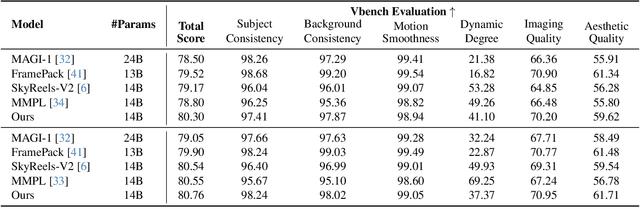

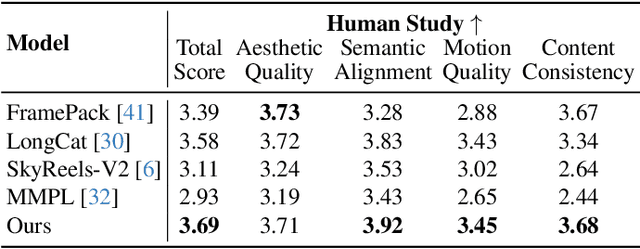
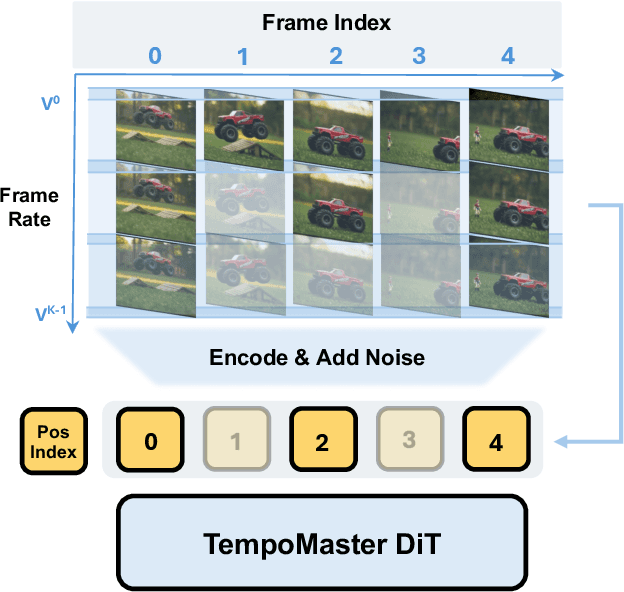
Abstract:We present TempoMaster, a novel framework that formulates long video generation as next-frame-rate prediction. Specifically, we first generate a low-frame-rate clip that serves as a coarse blueprint of the entire video sequence, and then progressively increase the frame rate to refine visual details and motion continuity. During generation, TempoMaster employs bidirectional attention within each frame-rate level while performing autoregression across frame rates, thus achieving long-range temporal coherence while enabling efficient and parallel synthesis. Extensive experiments demonstrate that TempoMaster establishes a new state-of-the-art in long video generation, excelling in both visual and temporal quality.
Blind-Spot Guided Diffusion for Self-supervised Real-World Denoising
Sep 19, 2025Abstract:In this work, we present Blind-Spot Guided Diffusion, a novel self-supervised framework for real-world image denoising. Our approach addresses two major challenges: the limitations of blind-spot networks (BSNs), which often sacrifice local detail and introduce pixel discontinuities due to spatial independence assumptions, and the difficulty of adapting diffusion models to self-supervised denoising. We propose a dual-branch diffusion framework that combines a BSN-based diffusion branch, generating semi-clean images, with a conventional diffusion branch that captures underlying noise distributions. To enable effective training without paired data, we use the BSN-based branch to guide the sampling process, capturing noise structure while preserving local details. Extensive experiments on the SIDD and DND datasets demonstrate state-of-the-art performance, establishing our method as a highly effective self-supervised solution for real-world denoising. Code and pre-trained models are released at: https://github.com/Sumching/BSGD.
MAGREF: Masked Guidance for Any-Reference Video Generation
May 29, 2025Abstract:Video generation has made substantial strides with the emergence of deep generative models, especially diffusion-based approaches. However, video generation based on multiple reference subjects still faces significant challenges in maintaining multi-subject consistency and ensuring high generation quality. In this paper, we propose MAGREF, a unified framework for any-reference video generation that introduces masked guidance to enable coherent multi-subject video synthesis conditioned on diverse reference images and a textual prompt. Specifically, we propose (1) a region-aware dynamic masking mechanism that enables a single model to flexibly handle various subject inference, including humans, objects, and backgrounds, without architectural changes, and (2) a pixel-wise channel concatenation mechanism that operates on the channel dimension to better preserve appearance features. Our model delivers state-of-the-art video generation quality, generalizing from single-subject training to complex multi-subject scenarios with coherent synthesis and precise control over individual subjects, outperforming existing open-source and commercial baselines. To facilitate evaluation, we also introduce a comprehensive multi-subject video benchmark. Extensive experiments demonstrate the effectiveness of our approach, paving the way for scalable, controllable, and high-fidelity multi-subject video synthesis. Code and model can be found at: https://github.com/MAGREF-Video/MAGREF
ATI: Any Trajectory Instruction for Controllable Video Generation
May 28, 2025Abstract:We propose a unified framework for motion control in video generation that seamlessly integrates camera movement, object-level translation, and fine-grained local motion using trajectory-based inputs. In contrast to prior methods that address these motion types through separate modules or task-specific designs, our approach offers a cohesive solution by projecting user-defined trajectories into the latent space of pre-trained image-to-video generation models via a lightweight motion injector. Users can specify keypoints and their motion paths to control localized deformations, entire object motion, virtual camera dynamics, or combinations of these. The injected trajectory signals guide the generative process to produce temporally consistent and semantically aligned motion sequences. Our framework demonstrates superior performance across multiple video motion control tasks, including stylized motion effects (e.g., motion brushes), dynamic viewpoint changes, and precise local motion manipulation. Experiments show that our method provides significantly better controllability and visual quality compared to prior approaches and commercial solutions, while remaining broadly compatible with various state-of-the-art video generation backbones. Project page: https://anytraj.github.io/.
CINEMA: Coherent Multi-Subject Video Generation via MLLM-Based Guidance
Mar 13, 2025Abstract:Video generation has witnessed remarkable progress with the advent of deep generative models, particularly diffusion models. While existing methods excel in generating high-quality videos from text prompts or single images, personalized multi-subject video generation remains a largely unexplored challenge. This task involves synthesizing videos that incorporate multiple distinct subjects, each defined by separate reference images, while ensuring temporal and spatial consistency. Current approaches primarily rely on mapping subject images to keywords in text prompts, which introduces ambiguity and limits their ability to model subject relationships effectively. In this paper, we propose CINEMA, a novel framework for coherent multi-subject video generation by leveraging Multimodal Large Language Model (MLLM). Our approach eliminates the need for explicit correspondences between subject images and text entities, mitigating ambiguity and reducing annotation effort. By leveraging MLLM to interpret subject relationships, our method facilitates scalability, enabling the use of large and diverse datasets for training. Furthermore, our framework can be conditioned on varying numbers of subjects, offering greater flexibility in personalized content creation. Through extensive evaluations, we demonstrate that our approach significantly improves subject consistency, and overall video coherence, paving the way for advanced applications in storytelling, interactive media, and personalized video generation.
Bringing Characters to New Stories: Training-Free Theme-Specific Image Generation via Dynamic Visual Prompting
Jan 26, 2025



Abstract:The stories and characters that captivate us as we grow up shape unique fantasy worlds, with images serving as the primary medium for visually experiencing these realms. Personalizing generative models through fine-tuning with theme-specific data has become a prevalent approach in text-to-image generation. However, unlike object customization, which focuses on learning specific objects, theme-specific generation encompasses diverse elements such as characters, scenes, and objects. Such diversity also introduces a key challenge: how to adaptively generate multi-character, multi-concept, and continuous theme-specific images (TSI). Moreover, fine-tuning approaches often come with significant computational overhead, time costs, and risks of overfitting. This paper explores a fundamental question: Can image generation models directly leverage images as contextual input, similarly to how large language models use text as context? To address this, we present T-Prompter, a novel training-free TSI method for generation. T-Prompter introduces visual prompting, a mechanism that integrates reference images into generative models, allowing users to seamlessly specify the target theme without requiring additional training. To further enhance this process, we propose a Dynamic Visual Prompting (DVP) mechanism, which iteratively optimizes visual prompts to improve the accuracy and quality of generated images. Our approach enables diverse applications, including consistent story generation, character design, realistic character generation, and style-guided image generation. Comparative evaluations against state-of-the-art personalization methods demonstrate that T-Prompter achieves significantly better results and excels in maintaining character identity preserving, style consistency and text alignment, offering a robust and flexible solution for theme-specific image generation.
DeTeCtive: Detecting AI-generated Text via Multi-Level Contrastive Learning
Oct 28, 2024



Abstract:Current techniques for detecting AI-generated text are largely confined to manual feature crafting and supervised binary classification paradigms. These methodologies typically lead to performance bottlenecks and unsatisfactory generalizability. Consequently, these methods are often inapplicable for out-of-distribution (OOD) data and newly emerged large language models (LLMs). In this paper, we revisit the task of AI-generated text detection. We argue that the key to accomplishing this task lies in distinguishing writing styles of different authors, rather than simply classifying the text into human-written or AI-generated text. To this end, we propose DeTeCtive, a multi-task auxiliary, multi-level contrastive learning framework. DeTeCtive is designed to facilitate the learning of distinct writing styles, combined with a dense information retrieval pipeline for AI-generated text detection. Our method is compatible with a range of text encoders. Extensive experiments demonstrate that our method enhances the ability of various text encoders in detecting AI-generated text across multiple benchmarks and achieves state-of-the-art results. Notably, in OOD zero-shot evaluation, our method outperforms existing approaches by a large margin. Moreover, we find our method boasts a Training-Free Incremental Adaptation (TFIA) capability towards OOD data, further enhancing its efficacy in OOD detection scenarios. We will open-source our code and models in hopes that our work will spark new thoughts in the field of AI-generated text detection, ensuring safe application of LLMs and enhancing compliance. Our code is available at https://github.com/heyongxin233/DeTeCtive.
You Only Look Around: Learning Illumination Invariant Feature for Low-light Object Detection
Oct 24, 2024Abstract:In this paper, we introduce YOLA, a novel framework for object detection in low-light scenarios. Unlike previous works, we propose to tackle this challenging problem from the perspective of feature learning. Specifically, we propose to learn illumination-invariant features through the Lambertian image formation model. We observe that, under the Lambertian assumption, it is feasible to approximate illumination-invariant feature maps by exploiting the interrelationships between neighboring color channels and spatially adjacent pixels. By incorporating additional constraints, these relationships can be characterized in the form of convolutional kernels, which can be trained in a detection-driven manner within a network. Towards this end, we introduce a novel module dedicated to the extraction of illumination-invariant features from low-light images, which can be easily integrated into existing object detection frameworks. Our empirical findings reveal significant improvements in low-light object detection tasks, as well as promising results in both well-lit and over-lit scenarios. Code is available at \url{https://github.com/MingboHong/YOLA}.
Towards Unified 3D Hair Reconstruction from Single-View Portraits
Sep 25, 2024



Abstract:Single-view 3D hair reconstruction is challenging, due to the wide range of shape variations among diverse hairstyles. Current state-of-the-art methods are specialized in recovering un-braided 3D hairs and often take braided styles as their failure cases, because of the inherent difficulty to define priors for complex hairstyles, whether rule-based or data-based. We propose a novel strategy to enable single-view 3D reconstruction for a variety of hair types via a unified pipeline. To achieve this, we first collect a large-scale synthetic multi-view hair dataset SynMvHair with diverse 3D hair in both braided and un-braided styles, and learn two diffusion priors specialized on hair. Then we optimize 3D Gaussian-based hair from the priors with two specially designed modules, i.e. view-wise and pixel-wise Gaussian refinement. Our experiments demonstrate that reconstructing braided and un-braided 3D hair from single-view images via a unified approach is possible and our method achieves the state-of-the-art performance in recovering complex hairstyles. It is worth to mention that our method shows good generalization ability to real images, although it learns hair priors from synthetic data.
ViMo: Generating Motions from Casual Videos
Aug 13, 2024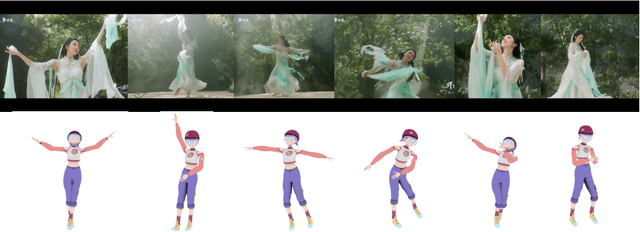

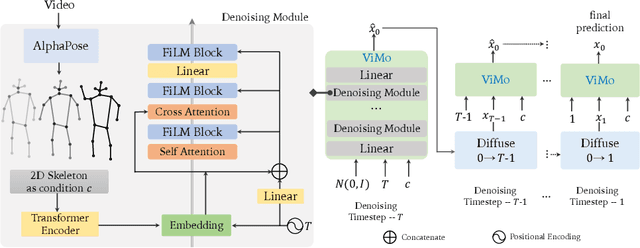

Abstract:Although humans have the innate ability to imagine multiple possible actions from videos, it remains an extraordinary challenge for computers due to the intricate camera movements and montages. Most existing motion generation methods predominantly rely on manually collected motion datasets, usually tediously sourced from motion capture (Mocap) systems or Multi-View cameras, unavoidably resulting in a limited size that severely undermines their generalizability. Inspired by recent advance of diffusion models, we probe a simple and effective way to capture motions from videos and propose a novel Video-to-Motion-Generation framework (ViMo) which could leverage the immense trove of untapped video content to produce abundant and diverse 3D human motions. Distinct from prior work, our videos could be more causal, including complicated camera movements and occlusions. Striking experimental results demonstrate the proposed model could generate natural motions even for videos where rapid movements, varying perspectives, or frequent occlusions might exist. We also show this work could enable three important downstream applications, such as generating dancing motions according to arbitrary music and source video style. Extensive experimental results prove that our model offers an effective and scalable way to generate diversity and realistic motions. Code and demos will be public soon.
 Add to Chrome
Add to Chrome Add to Firefox
Add to Firefox Add to Edge
Add to Edge